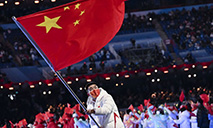Olympic mascot craze shows consumption, growth linked
For me, one of the abiding memories of the Beijing 2022 Winter Olympic Games will be the amazing popularity of the mascot Bing Dwen Dwen.
The licensed online store selling Olympic souvenirs announced the presale of Bing Dwen Dwen keychains would kick off at 4 pm on Feb 9. I was determined to own the endearing mascot. So, I placed the order for some keychains by adding them to my shopping e-cart well in advance and waited eagerly for the critical moment to arrive so I could promptly click and pay.
As the big day arrived and the clock struck 4, I held my breath and tapped on the "pay" button on my smartphone screen in a jiffy, without wasting a nanosecond. Yet, wonder of wonders, the flash sale, it seemed, ended for me even before it began.
The e-store announced on my phone screen, rather coldly and heartlessly, I should add, that the keychains were either sold out already or out of stock as demand outstripped supply.
I can assure you mine wasn't the only heart that lay broken. On social media platform Weibo, the topic of "Bing Dwen Dwen sold out "received the attention of-wait for it-more than 290 million people! I learned later that 1 million Bing Dwen Dwen-themed products launched on Feb 20 were all sold out on the same day.
Will the craze for owning Bing Dwen Dwen products continue? Maybe it will. Perhaps not. But I'd like to bet the phenomenon epitomizes a trend that will continue and bolster China's economic prospects this year. And that is, the great potential of China's consumer market.
Chinese consumers have a growing appetite for goods and services that satisfy not just the superficial or physical dimension of one's being but also deeper, more profound aspirations. This pursuit has been a driver of consumption upgrade in China.
With the continuous rise in Chinese consumers' living conditions and income levels, consumption upgrade will likely deepen this year and even drive economic growth.
Economic data attest to my assertion. For instance, retail sales of gold, silver and jewelry grew by almost 30 percent year-on-year last year; similarly, sales of sports and entertainment products expanded 22 percent; and sales of cultural products and office supplies rose by nearly 19 percent.
All these categories outpaced the 12.5 percent growth in total retail sales, the National Bureau of Statistics said.
But I must hasten to add that China's consumption recovery is not without challenges. In fact, consumption has been a laggard in China's economic recovery due to factors like the lingering uncertainties of COVID-19, the induced weaker consumer sentiment and slower wage growth compared with the pre-pandemic levels.
That's why I believe the upcoming two sessions, or the annual sittings of China's national legislature and the top political advisory body, will announce more measures to bolster consumption growth. Last year, final consumption expenditure contributed nearly two-thirds of China's economic growth.
The two sessions may launch more policies to boost big-ticket spending in areas like automobiles and home appliances as well as emerging fields of consumption like energy-saving and digital products and services.
More importantly, the two sessions are expected to highlight the government's commitment to safeguarding smaller businesses and a stable employment situation, which act as the ultimate foundation for consumption to recover.
"A key to this year's growth is consumption recovery, which needs a solid recovery of employment by small and medium-sized enterprises and the services sector," said Wang Tao, head of Asia economics and chief China economist at UBS Investment Bank.
Indeed, challenges like COVID-19 uncertainties may still complicate any consumption rebound in the near future, but the structural shift of the Chinese economy that is turning more reliant on consumer spending will gradually manifest itself over time.
As Zhu Haibin, JPMorgan's chief China economist, said, the country's nominal growth in retail sales may normalize to the pre-pandemic levels of around 8 percent year-on-year this year, thanks to the continuous recovery in residents' income level and the reducing propensity to save as COVID-19-related shocks fade.
Zhu said consumption may contribute more than 3 percentage points to China's GDP growth this year, which, he said, may come in at around 4.9 percent, although some other experts appear to agree on the 5.0-5.5 percent range.
Photos
Related Stories
- Feature: Norway's Pedersen fights against unfair treatment for para-athletes
- IPC, BOCOG presidents confident of successful Winter Paralympics
- High-level coordination mechanism at Beijing Winter Paralympics launched
- Feature: Chinese volunteers with fluent Turkish cultivated warm ties with Turks in Beijing
- High-level coordination mechanism at Beijing Winter Paralympics launched
Copyright © 2022 People's Daily Online. All Rights Reserved.










